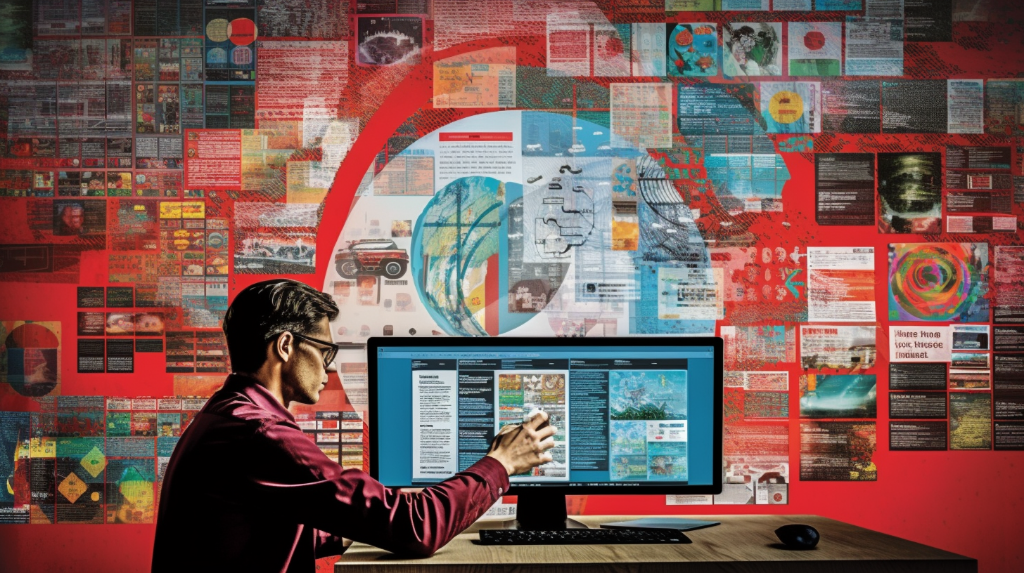As we continue to advance in the digital age, the importance of User Interface (UI) design has skyrocketed. UI designers play a pivotal role in creating interactive and satisfying user experiences across diverse digital platforms. From websites to mobile apps, and everything in between, the UI designer’s task is to make sure that users find the platform not only appealing but also easy to navigate.

But what exactly is a UI designer and why is there a soaring demand for this profession? Let’s dig deeper and understand this phenomenon.
Defining the Role of a UI Designer
A UI designer, or User Interface designer, is the individual responsible for designing the layout and look of a digital platform. This might include choosing the color scheme, designing the buttons, sliders, and all other interactive elements. They ensure that the design is consistent, intuitive, and engaging. Their ultimate goal? To provide the user with an effortless and enjoyable experience.
Think about the last time you used an app or a website. Did you find it easy to use? Was it visually appealing? If so, you have a UI designer to thank for that.
Understanding the Demand for UI Designers
The demand for UI designers is on the rise, and there are several factors contributing to this growth. One of the main reasons is the proliferation of digital products and services. As more businesses transition online, the need for user-friendly interfaces becomes crucial.
Whether it’s an e-commerce site or a mobile banking app, users expect a seamless experience. And this is where the skills of a UI designer come into play. But what does the job market look like for these professionals? Let’s find out.
Trends Affecting the Demand for UI Designers
As the tech industry evolves at a rapid pace, so does the need for UI designers. But what are the specific trends that are driving this demand? Let’s take a closer look.
Increase in Mobile App Development
Have you ever thought about how many apps you use each day? With the rise in mobile app development, there’s an increased necessity for UI designers. Companies are realizing that a user-friendly interface is not just a nice-to-have, but a must-have in today’s digital world. This is where UI designers come in, creating intuitive, easy-to-navigate apps that keep users coming back for more.
Growth of Virtual Reality and Augmented Reality
Virtual Reality (VR) and Augmented Reality (AR) used to be the stuff of science fiction, but they’re rapidly becoming a part of our everyday lives. Whether it’s gaming, education, or healthcare, VR and AR technologies are being adopted across various industries. And guess what? They all need UI designers. The development of VR and AR technologies has led to a need for specialized UI designers who can create immersive, interactive experiences that are both engaging and easy to use.
The Job Market for UI Designers
Now, let’s turn our attention to the current job market for UI designers. It’s one thing to say that UI designers are in demand, but what does the job market actually look like?
| Company Type | Salary Range | Job Satisfaction |
|---|---|---|
| Startups | $50,000 – $70,000 | High |
| Mid-sized Companies | $70,000 – $90,000 | High |
| Large Corporations | $90,000 – $110,000 | Very High |
| Freelance | $30,000 – $100,000 | Varies |
As you can see from the table above, UI designers are being hired across a range of company types, from startups to large corporations. The salaries are competitive, and job satisfaction rates are generally high. This paints a promising picture for anyone considering a career in UI design.
Skills Required to Become a UI Designer
UI design is a field that requires a unique blend of both technical and interpersonal skills. A successful UI designer not only needs to have a good understanding of design principles, but they also need to be able to communicate effectively with clients and team members. So, what specific skills should a budding UI designer strive to acquire?
Technical Skills
First and foremost, a UI designer must be proficient in design software. This can include tools like Sketch, Adobe XD, and Illustrator. Knowledge of HTML, CSS, and JavaScript is also a significant advantage, as these languages are commonly used in UI design.
Another crucial technical skill is an understanding of user-centered design principles. This involves knowing how to create interfaces that meet the needs of the user, and provide a satisfying and interactive experience.
Interpersonal Skills
While technical skills are vital, a good UI designer also needs strong interpersonal skills. Communication is key in this role, as designers often need to collaborate with developers, product managers, and clients. The ability to clearly articulate design ideas and decisions is therefore crucial.
Furthermore, UI designers must be empathetic and user-focused. They need to understand the needs, motivations, and behaviors of users in order to create interfaces that are intuitive and user-friendly.
- Proficiency in design software (e.g., Sketch, Adobe XD, Illustrator)
- Understanding of user-centered design principles
- Knowledge of HTML, CSS, and JavaScript
- Strong communication skills
- User-focused and empathetic
How to Get Started as a UI Designer
Are you interested in becoming a UI designer but not sure where to start? Don’t worry, we’ve got you covered. The journey towards becoming a UI designer involves education, portfolio building, and gaining experience.
Firstly, it’s essential to get educated. This doesn’t necessarily mean getting a degree in design, although that can be beneficial. There are plenty of online courses and boot camps that can teach you the necessary skills. It’s crucial to learn about design principles, color theory, typography, and of course, how to use design software.
Building a portfolio is the next step. This is your chance to apply what you’ve learned and create some work samples. You can start with hypothetical projects, or even redesign the interface for an existing app or website. Remember, the goal is to demonstrate your ability to create user-friendly and aesthetically pleasing interfaces.
Finally, gaining real-world experience is invaluable. This might involve taking on an internship, or doing some freelance work. The more experience you can get, the better. Not only will this help you build your portfolio, but it will also give you a taste of what it’s like to work in the field.
So, are you ready to kick-start your journey towards becoming a UI designer? Remember, it’s a journey that requires both technical and interpersonal skills. But with dedication and a willingness to learn, it’s a journey that can lead to a rewarding and in-demand career.

The Future Demand for UI Designers
Given the ever-evolving nature of the technology industry, can we predict the future demand for UI designers? The answer is both yes and no. The constant advancements in technology and the growing need for digital interfaces almost assure that UI designers will continue to be in demand. However, like any other profession, the landscape of UI design might experience changes due to the introduction of new technologies and trends.
For instance, the rise of Artificial Intelligence (AI) and Machine Learning (ML) has started to influence the UI/UX design process. While this might seem like a threat, in reality, it opens up a whole new avenue for UI designers to explore and grow. By integrating AI and ML into the design process, designers can create more personalized and interactive user experiences.
Final Thoughts on the Demand for UI Designers
In conclusion, the demand for UI designers is influenced by a multitude of factors. Despite the challenges and changes in the tech landscape, the prospects for UI designers continue to look promising. The need for effective and engaging user interfaces is not going away anytime soon. In fact, with the rise of new technologies, the role of UI designers is likely to become even more crucial.
So, what does this mean for aspiring UI designers? It means that there is a world of opportunities waiting for you in the tech industry. However, it also means that you need to stay adaptable and open to learning new skills and technologies to keep up with the industry trends.
- UI design is a flourishing field with a high demand in the tech industry.
- The role of a UI designer is crucial in creating user-friendly digital interfaces.
- The demand for UI designers is influenced by various factors, including the rise of new technologies and trends.
- Despite potential challenges, the future for UI designers looks promising.
- Aspiring UI designers should stay adaptable and continually learn new skills.
